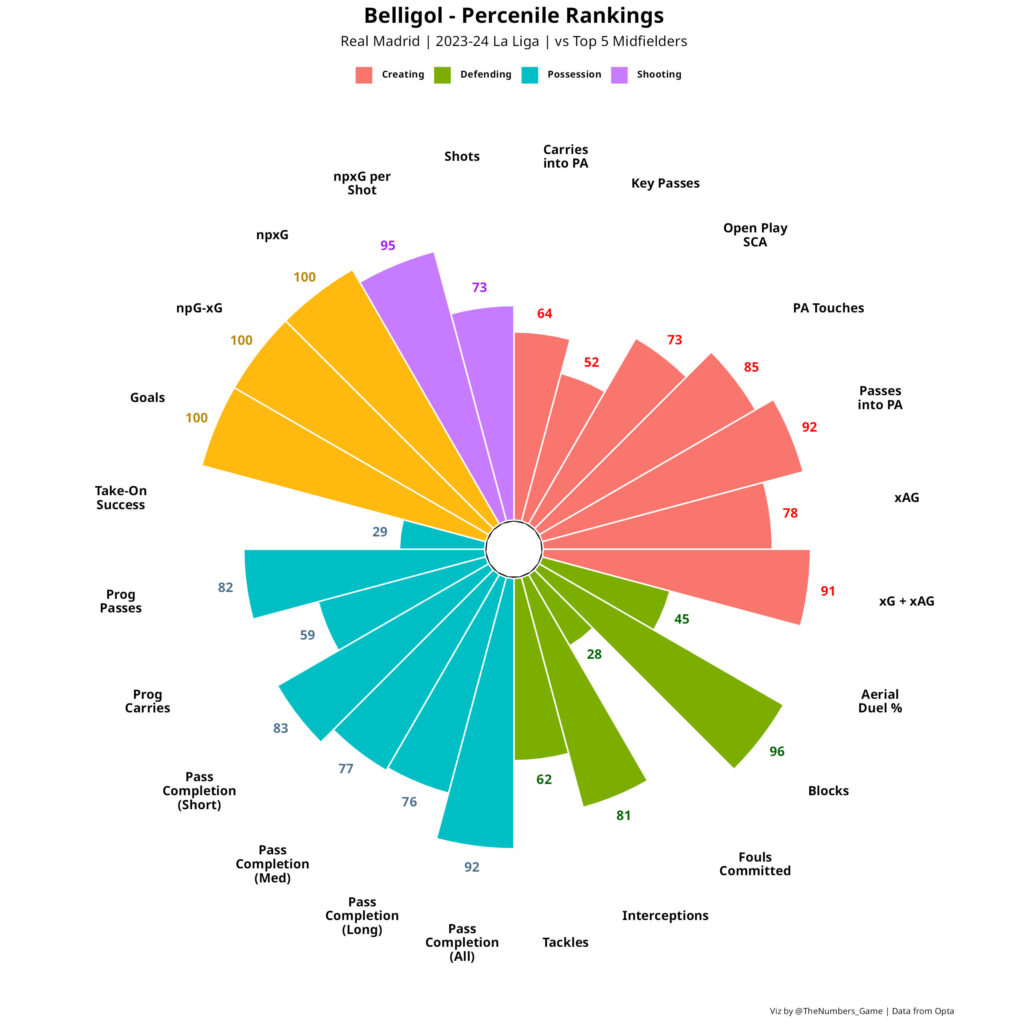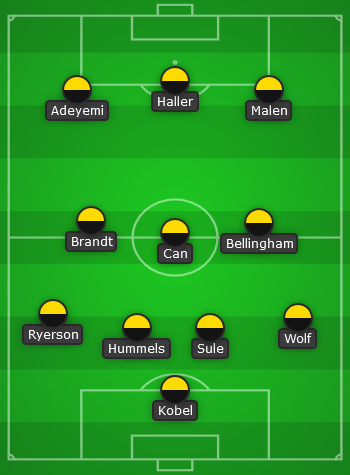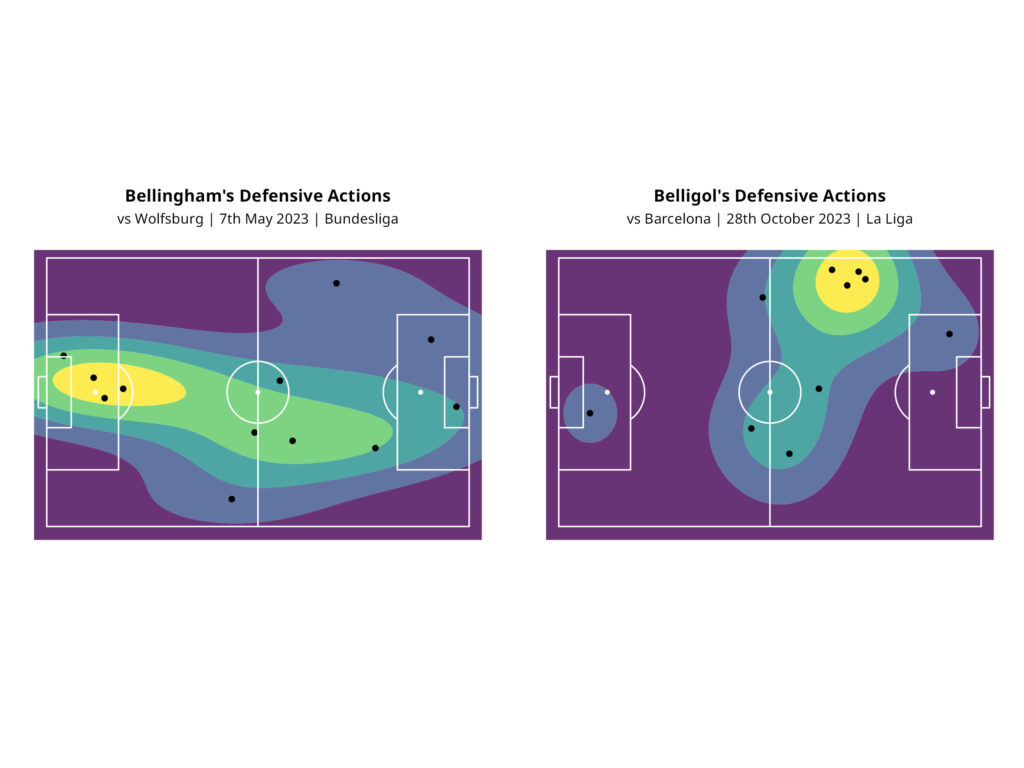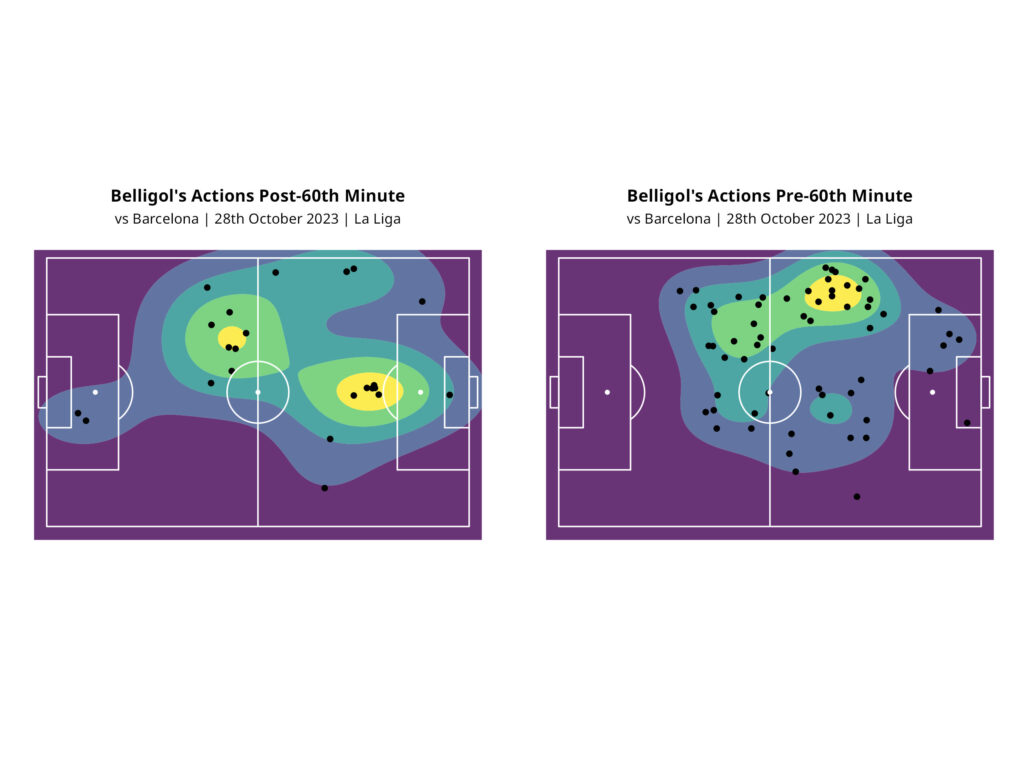You’ve probably seen the memes by now. Real Madrid’s latest hit no longer goes by “Jude Bellingham”, but now by “Belligol”. This name was bestowed on the Englishman after his goalscoring antics this season in La Liga. A single-handed snatching of 3 points against Barcelona this season solidified his new status.
We may be calling him by a different name now, but how has Jude Bellingham’s playstyle changed since leaving Borussia Dortmund? Is “Belligol” really all that different from “Bellingham”? Let’s find out by consulting the numbers and take an extensive look at what’s changed.
The Big Picture

Firstly, let’s look at the bigger picture. We can look at pizza plots to get a look at the shape of a player’s strengths and weaknesses before we get more in-depth. For simplicity, when I refer to “Jude Bellingham”, I am referring to the Borussia Dortmund midfielder of the 2022-23 Bundesliga season. When I refer to “Belligol” … I’m talking about “Belligol”.
Jude Bellingham’s pizza plot tells a story of a very well-rounded player. Very high percentile rankings for creativity when put up against other midfielders from Europe’s top five leagues tell us that Bellingham’s output in the final third and penalty area were helpful in Dortmund’s title challenge. Whilst he was involved in the shooting game, his finishing wasn’t amazing, ranking in the 37th percentile for overperformance on expected goals. In possession, Bellingham’s focus was on getting the ball forward and into dangerous positions. This can be shown by the combination of high rankings for progressive passes and carries (96th for both) and lower rankings for short and medium ranged pass completion (41st and 52nd).
A high-risk, high-reward kind of player, Jude could be relied on to bring the ball forward using his press resistance (73rd percentile ranking for take-on success) and find a teasing pass. Off the ball, and Bellingham still ranked decently whilst not overly impressing. That said, an 85th percentile ranking for blocks does suggest that his reading of the game still held in the defensive aspect of the game.

Belligol, on the other hand, is a bit more specialised. The golden bars for goals, non-penalty xG and xG overperformance represent the fact that Belligol ranked 1st in those metrics. That is, his finishing has been the best in Europe so far. Granted, his average npxG per shot is high (95th percentile), but the fact that he is regularly getting into those positions is testament to his movement in and around the penalty area. Since Belligol is taking more shots, the pizza plot shows a decrease in creative rankings. However, these numbers are still around the elite, or 80th percentile, range.
Defensively, that intelligence in reading opponents is showing, with high rankings for interceptions (81) and blocks (96). When in possession, Bellingham’s pass completion seems a lot higher, but his take-on success looks lower. Perhaps this is down to the defensive 3rd strength of La Liga defences, but details that I will go into later suggest that this is merely a tactical consequence.
Now that we’ve seen the shapes of the data, with Belligol looking like a “min-maxed” version of Bellingham, favouring penalty area prowess over high-volume ball progression, we can look a bit deeper at individual metrics and how the Englishman has changed.
The Specialisation of Bellingham

We can use bar charts to directly compare Bellingham to Belligol on the metric-level. Firstly, looking at his creative metrics, we can see that the two are very close on all fronts. This is except for carries into the penalty area, where Bellingham ranks in the 97th percentile, compared to Belligol’s 64th percentile ranking.
It’s not like he’s passing any less than he did last season, so we can conclude that Belligol is simply making fewer penalty area entries. This may also be down to a tactical shift between Dortmund and Real Madrid, with the burden of creation taken off Belligol’s shoulders. We can take the 13-percentile ranking point fall in expected assisted goals as evidence of this.

The difference between Bellingham’s shooting last season and this season is night and day. Going from ranking in the lower third of European midfielders in terms of xG overperformance to number 1 is incredible. “Belligol” really has been a suitable nickname for the player.
Shooting and ballstriking is something that I’ve covered before in articles. To reiterate, one of the factors that can determine a player’s shooting ability is confidence. It’s affected teams like Chelsea in a negative way over the past couple of years but has given someone like Bellingham a massive boost. The ability to focus and not second guess can allow a player to get a much better hit on the ball – and ultimately bag vital goals for the team. Bellingham is shooting less, but the quality of chances he’s been getting has improved. Perhaps this is down to the players around him being able to create better chances?

Defensively, we can see Belligol winning fewer aerial battles and committing more fouls, but winning more interceptions and getting more blocks. In other words, he’s a lot more aggressive in his defending this season. There are few reasons why this may be the case. Given that he’s getting into the box more this season, defensive actions will take place further up the field. In fact, this leads us to our next section.
It’s All Tactical
I’ve mentioned tactical differences a couple of times so far. Carlo Ancelotti and Edin Terzic are two managers with completely different playstyles in two very different leagues. Where and how Jude Bellingham has been deployed by the two managers plays a significant role in the statistical differences between how he played last year and this year.

Here’s a case study. In Real Madrid’s 2-1 El Classico win over Barcelona on the 28th of October 2023, Carlo Ancelotti deployed Bellingham as the attacking-most midfielder in a 4-3-1-2, diamond formation, playing as something of a shadow striker in behind the front two of Rodrigo and Vinicius Junior.

However last season, whilst Dortmund’s shape and personnel changed a lot over the season, Terzic played Bellingham as the right-most midfielder in a flat 4-3-3 formation against Wolfsburg in early May. Dortmund played most of the season in a 4-2-3-1, with Bellingham as the right side of a double pivot, so this match against Wolfsburg wasn’t too out of the norm.
Just from formation alone, we can see that where Bellingham is doing his work, and what work he’s been required to do at Real Madrid is very different compared to last season, hence the difference in output.

Going back to defensive output, Belligol is going to be doing more of his defensive work as part of a pressing system. This is compared to as part of a defensive unit defending transitions as they’re happening. We can see this by looking at heatmaps, showing where Bellingham’s defensive actions happened in both matches. For Dortmund, he was dotted all around the pitch, with many of his defensive actions happening around his own box. For Real, defensive duties were carried out higher up the pitch on the left side, where Jude tends to operate.
When playing higher up, fewer tackles are going to be made and more interceptions and blocks will be necessary. Arguably this is harder work for a midfielder, since it relies more on reading the game and stamina in the press as compared to physical strength when making challenges in the defensive third. These traits were found in Bellingham last season, shown by his work across the field and high ranking for blocks.
You can also be more reckless when pressing higher up the field, with tactical fouls being an important part of a team’s defence against transition. This explains Belligol’s previously shown increase in fouls committed.

Looking at all of Bellingham’s actions against Wolfsburg now, we have two images of a true box to box midfielder. As part of that midfield three, most of his actions took place in the middle third of the pitch in the right half-space. However, this doesn’t mean that he wasn’t more or less everywhere on the pitch all the time. His pass map, spread out all across the field, shows just how active he was in possession for Dortmund. A lot of his passes were longer, with the majority of his unsuccessful passes being long balls towards or across the box.

Against Barcelona, Bellingham had his specific area to work in – down the left hand side of the pitch – whilst also attacking central areas. In fact, there was something of a tactical shift as the game progressed against Barca. Looking at Bellingham’s actions before and after the 60th minute, we can see that when looking for goals, he found himself in more attacking central areas, as opposed to the left sided positions that he tended to take previously.

Going back to the general look on the game, we can see that Bellingham’s passes were much shorter and safer. This explains the increase in pass completion this season compared to last. Most of these passes were made in deeper areas as well, with fewer teasing balls in and around the ball. This makes sense of the lowered creative numbers we’ve seen this season.

Belligol has traded creating for shooting this year, as previously mentioned. We can also look at his shot maps to see this in effect. The shot hull – that polygon visible on the shot maps – represent the general area where Bellingham’s goals were scored. At Dortmund, that hull is further back, around the edge of the box and the penalty spot.
At Real Madrid (aside from that long-range first strike against Barca) we can see that Bellingham’s goals this season are happening exclusively in very dangerous areas, from the penalty spot upwards. Fewer involvements in deeper areas of the pitch mean more runs and shots in the penalty area in better positions.
This helps in explaining the increase in non-penalty xG. Evidence of his good movement is also shown by the increase in xG per shot, from 0.13 to 0.21. However, the increase in shooting quality comes down to confidence and technical quality rather than gameplan.
Bellingham vs Belligol
Now that we’ve taken a rigorous look at the difference between Bellingham and “Belligol”, let’s conclude. At Borussia Dortmund, Bellingham’s role found him impacting the game in all areas, in front of his own penalty area and in the final third. Being asked to help in build-up, carrying the ball forward and creating chances, Bellingham’s passes were often lower percentage passes. However, this led to a high volume of creation.
At Real Madrid however, Bellingham’s role has been refined. Playing further up the field, first phase build-up and back line defensive responsibilities have been swapped out for penalty box presence and pressing. This has inevitably led to better goalscoring opportunities for Bellingham, but a lesser creative volume. With the burden of creation placed on different players’ shoulders, his passes have been safer. As a result, his progression numbers have decreased. However, his incredible game intelligence has helped. His movement has been getting him into high xG positions for shots whilst being very effective in the press.
Is “Belligol” an improvement on Bellingham? Not necessarily. Do you value all action, box-to-box midfielders who can create and defend? Then Dortmund’s version of Jude Bellingham may even appeal to you more than Real Madrid’s more attacking, shadow striker-esque version. Either way, Bellingham’s ability to not only adapt to but thrive in a new system and league is a sign of a generational midfielder.
We’ve seen the birth of “Belligol”. If he continues with this good form, we’ll be enjoying this new creation for a long time.

